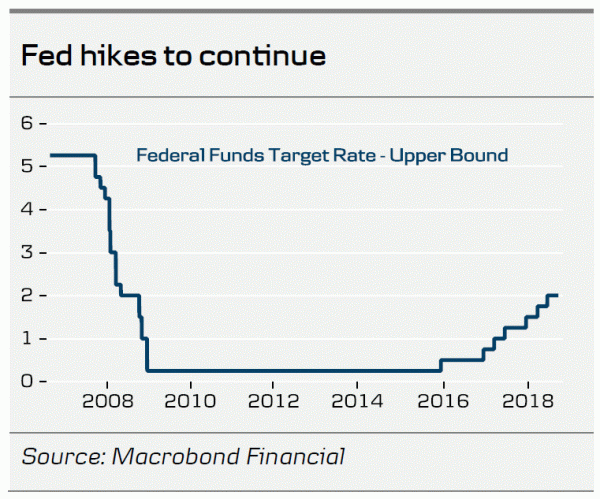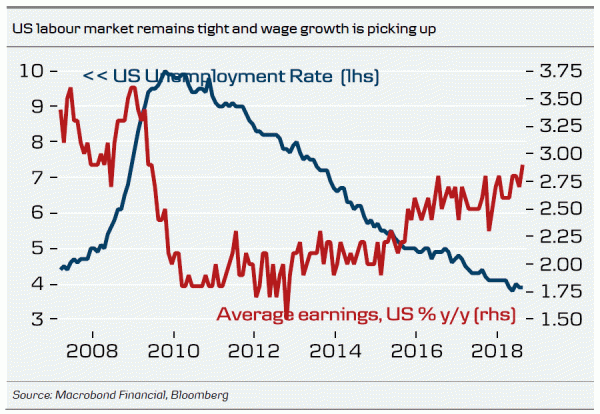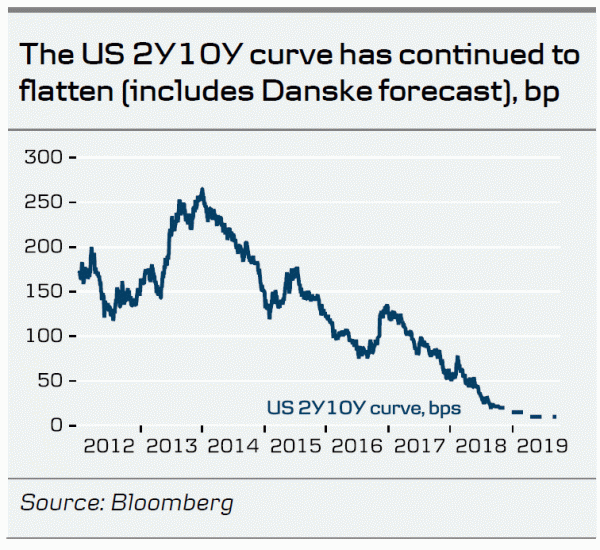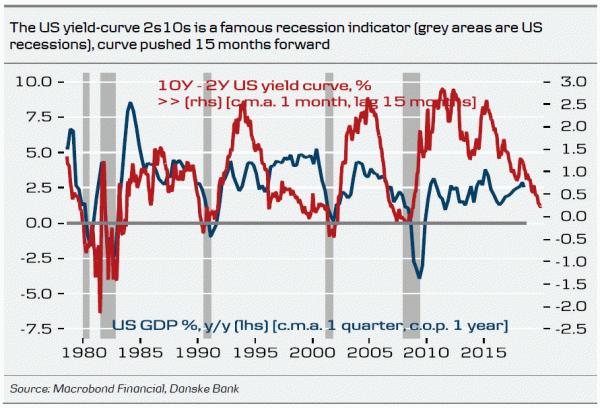The focal point in the European bond markets over the summer has been Italy. This has resulted in downward pressure on, in particular, German yields and in August the 10Y bund yield was as low as 0.30%. Simultaneously, the yield on the 10Y Italian government bond reached 3.25%.
However, over the past couple of weeks, the market has scaled back on its ‘Italian fears’. The new government has realised that it would be expensive (higher interest rate costs) to run a significant budget deficit. The latest comment from Finance Minister Giovanni Tria clearly indicates that the Italian budget will not breach the important 3% EU limit and that the budget deficit could be ‘just’ 2%. We expect the market focus on Italy to be less ahead, as we assume the budget deficit will stay below the 3% limit.
The next focal point for Italy is 27 September, when the Economic and Financial Update is due for release. It contains updated growth, debt and deficit projections. Also pivotal is the 15 October deadline for the submission of the budgetary plan to the EU Commission.
This does not mean Italy’s budget troubles are over but merely that Italy is moving down the agenda and that we are moving back to a more normal market in respect of drivers for the fixed income market.
Still no strong drivers for higher EUR rates for the rest of 2018
The outlook for core inflation is still modest for the eurozone and we see little risk of a rate hike before December 2019, when we pencil in a first ECB rate hike of 20bp. Indeed, it seems to us that the European business cycle weakened slightly in the spring and over the summer. Overall, we continue to expect 10Y German yields to range-trade in a narrow 0.3-0.5% range for the rest of 2018.
Modest upward pressure in 2019
We continue to see modest upward pressure on yields and rates in Europe in 2019. The first ECB rate hike is moving closer and the ECB QE programme is widely expected to have ended. The latter has created some concerns that we could see a jump in yields like we saw in the US in 2013, when the Federal Reserve scaled back on bond purchases (tapering).
In 2013, 10Y US yields rose more than 1% over a few months. However, given that the end to ECB QE has been well communicated and that reinvestment of bonds maturing is set to continue in 2019, it is not our main case that the end to QE will have a major impact on EUR rates.
Fed on autopilot until neutral is reached
An important factor for longer dated European rates and yields is long US yields and where they are heading in 2019. Over the past couple of months, we have seen a series of strong US numbers and, importantly, the labour market has continued to tighten. In particular, we note that US wage growth finally seems to be picking up. Closely followed average earnings came in at 2.9% y/y in August. This was the highest level since 2019.
In particular, the labour market numbers mean the Fed is on autopilot right now and it is quite certain that it will hike both at the meeting later this month and again in December, which would take the Fed funds rate to 2.50% year-end.
At the press conference following the June meeting, Jerome Powell elaborated on why the Fed removed a lot of its forward guidance from the statement. He hinted that the Fed wants more flexibility, as the Fed funds rate is approaching the neutral rate (the rate where monetary policy is neither expansionary nor contractionary), which most FOMC members estimate is in the 2.75-3.00% range. We believe it will be more ‘stop and go’ for the Fed when it has reached neutral, which we believe is likely to happen in March 2019.
While the US economy is strong with high optimism, strong GDP growth, a low unemployment rate and stronger wage growth, there are also warning signs out there, not least the flattening of the US yield curve, and we think the Fed will adjust accordingly if markets start to send a strong recession signal. It is also easier for the Fed to do this, as every meeting next year is ‘live’, with Fed Chair Powell starting to host a press conference after each Fed meeting. Our base case remains that the Fed will be able to continue hiking in 2019.
Flatter US curve – will it invert?
Over the past couple of years, we have witnessed a pronounced flattening of the US curve, where 2s10s has moved from 125bp at the beginning of 2017 to around 22bp currently. It is well known in both academia and financial markets that an inversion of the yield curve over the past 50 years has been able to predict a recession in one to two years. Hence, the inversion itself can affect how the market is pricing its Fed funds expectations and in the end affect actual monetary policy as we argue above. If the curve were to invert, the Fed would probably be more reluctant to hike rates.
We do not forecast an inversion of the 2Y10Y curve in treasuries on a 12M horizon but, in our view, it will be very close. First, we expect the market to price a very flat to inverted money-market curve, keeping 2Y yields in check after all. In our opinion, the market is unlikely to price the Fed hikes we forecast beyond our 12M forecast horizon.
Furthermore, we continue to hold the view that 10Y treasury yields will move above the 3% level in 2019, as the labour market remains tight and the funding need continues to rise due to the expansive US fiscal policy.
However, we expect the 2Y10Y curve to be very flat and believe we should expect a lively discussion about whether this is a signal a new US recession is getting closer. We expect 10Y US Treasury yields to reach 3.25% on a 12M horizon. We expect the curve 2Y10Y to flatten to just 10bp in 2019 and believe temporary inversions throughout 2019 are likely.
The 2Y10Y curve is not the only financial variable that has predictive power in respect of US recessions. Another model is to look solely at the money-market curve. If it inverts and the market starts to price in rate cuts in one to two years, it is a reliable indicator. Others have suggested using the 3M money-market rate instead of the 2Y bond yield. If this is the case, the yield is still some way from inverting.
The point is that both the Fed and the market will look at different indicators to judge whether a recession is underway, not just the 2Y10Y spread.
Wider spread between USD and EUR rates
We continue to see a further widening of the two-year spread between USD and EUR rates. We expect the Fed to hike twice more this year and to continue hiking next year. Importantly, we still expect the Fed to raise the Fed funds rate above the longer run dot of 2.83% (the Fed’s estimate of the natural rate of interest when the economy is normalised) in coming years. We see a peak at 3.25% in 2020.
Conclusion: higher yields mainly an autumn 2019 story
We keep our 12M forecast for German 10Y yields unchanged at 0.8% and we continue to expect a steeper 2Y10Y German yield curve in 2019. The ECB still maintains a relatively tight grip on the short end of the curve, especially with the first ECB rate hike expected late in 2019.
We plan to publish the next issue of Yield Outlook in mid-October.

















